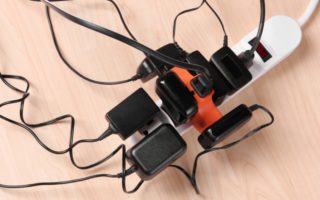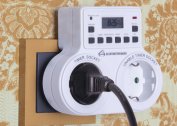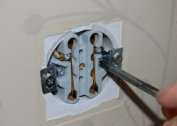A circuit breaker is a device for disconnecting DC or AC circuits. Located on the dashboard, at the entrance to the apartment or house. The device is a protection against short circuit and overload of electrical wiring. It is necessary to understand why the machine is knocked out in the shield, and what to do if it is repeatedly activated.
Features of the circuit breaker
A circuit breaker (AB) is a switching contact device that is able to turn on current, conduct it and turn it off. It functions both in emergency situations and under normal conditions in the circuit for a specified time. AB simultaneously plays a protective and controlling role. Such devices perform the following tasks:
- blackout of the site in case of power problems;
- circuit disconnection during short circuit;
- protection against overloads during the passage of excessively high currents.
The characteristics of the machine depend on the format of the protected network section. The device must control the current parameters, if any, exceed the permissible threshold values, avoiding overloads, and also disconnect the section in case of short circuit, overheating of the wires.
Depending on the function performed, there are automatic machines for minimum and maximum current, minimum voltage and reverse power. By design features distinguish modular devices. They are used in domestic networks, where currents are small. Basically, these are unipolar or bipolar devices. Cast switches are installed in industrial conditions with a current of up to 1 kA. Aerial electric machines are used in circuits with powerful installations. They withstand current up to 6.3 kA.
There are protective shutdowns such as RCDs and difavtomat. The first device is not a complete protection of the circuit and the devices included in it.
RCD functions - prevention of electric shock. The differential circuit breaker combines a circuit breaker and a residual current circuit breaker in one device.
The reasons for the operation of the machine
Turning off the circuit breaker may be due to a short circuit or overload of the wiring, a malfunction of the device itself or connected household appliances. The device can be turned on again, but before that it is important to determine why the machine was knocked out.
Network congestion - the most common reason that a machine is knocked out. This is an emergency operation in which the passing current is higher than the permissible rated value. Most often, the situation happens when several devices are connected to one outlet. For example, if there is a socket for two sockets and a washing machine and a microwave are included in it at the same time. The load increases, the circuit breaker trips. Also, overload can occur due to the fault of the supplier when voltage drops occur.
During the design and installation of electrical wiring, it is impossible to accurately determine the load on a group of outlets. Usually 3-4 AV outlets are connected to one AV. If a powerful device is installed, the current value of the sockets is reduced. If you connect several powerful devices to one of them at once, the machine will work. This phenomenon can be avoided if the powerful load is evenly distributed, the devices are included in different groups of outlets. If this is not possible, they should be connected in turn.
There are three ways out of this situation: use large household appliances one at a time, purchase a more powerful device, or replace the wiring that can withstand heavy loads.
Home appliance breakdown - The second reason why the machine cuts down. If this happens at the same time, you need to look for a faulty technique. For example, the regularity of AB operation when the electric stove is turned on, the washing machine is started, or when the boiler starts heating water is obvious. To identify the culprit, you should turn off all devices. Then turn on gradually one at a time until the machine shuts down again. If the AV is not knocked out, the breakdown lies precisely in household appliances.
You can detect a malfunction of the appliance by temporarily connecting it to another distribution group, which is designed for more current. If the machine continues to turn off, the problem is in the device itself, otherwise the culprit is the wiring in the places of its connection.
Malfunction of lighting devices can also lead to knocking out the machine. Most often it is short in the base of an electric lamp. To detect damage to the base, you need to unscrew all the bulbs. Then screw them one by one and turn on the light. Sometimes burnout occurs due to a malfunction of the switch. A single shutdown of the machine when the bulb is burned is associated with a short-term load that the machine cannot withstand at 6-10 A. LED and fluorescent devices do not have such an effect on the network.
Breakdown of the circuit breaker often leads to blackout. Even externally functional AB can work. Sometimes a damaged device makes a faint, rattling sound. The long term of operation leads to the natural wear of all elements, their technical parameters deteriorate. The releases lose their functions, the conductors heat up. Such a machine must be replaced. To avoid trouble, you should choose a quality device from well-known manufacturers.
Short circuit accompanies any action. Most often this happens when drilling a wall and damaging the wiring or during repair of a de-energized outlet, if you accidentally short-circuit the phase and zero. The same phenomenon occurs when it is necessary to correct the contacts in the cartridge with a tool. In these cases, the machine operates instantly. The device cannot be turned on immediately, you need to make sure that there is no damage to the wires, contacts or cartridge.
Another reason for the short circuit is the flooding of the apartment with water. Getting on the insulation, water washes away its adhesive layer. The insulating tape is glued, which leads to a short circuit. Therefore, after flooding, you need to inspect the machine and all contacts.
Bad contact or oxidation causes the machine to trip. More often this applies to aluminum wiring. Since this metal is soft and fluid, contacts become weaker over time. To detect a malfunction, you need to sequentially go through the entire chain. To do this, you should check the machine, then junction boxes, disassemble all sockets, switches and chandeliers in order to assess the quality of connecting the wires to the terminals. If the wires are loose, tighten the clamps. The terminals must be checked at least once a year.
Problems with the difavtomat conditionally divided into three groups: failure of the device itself, problems with the load or in a line controlled by the machine. In old wiring, insulation wear leads to current leakage. If the machine is knocked out in the shield, the problem may be damage to the insulation during laying the wire, twisting, building up the wires.Also, the reason is the incorrect location of the junction box, miscalculations in insulation or electrical accessories. The solution to the problem is to check, starting from the introductory machine, and the gradual localization of individual sections.
To discover wiring faultwalled up under a layer of plaster is quite difficult. First of all, check the inlet switchgear. Modern meters have an LED indicator. If there is no voltage, a request should be made to the power supply organization for troubleshooting.
The main causes of a wiring failure:
- short circuit of ground wire or zero to phase;
- no contact on the terminals of the switch;
- wire break in the place of connection to outlets, switches, cartridges;
- breakdown of the cocking mechanism in the circuit breaker - the contacts do not open and do not close.
Due to mechanical stress, improper installation, damage by rodents or during repair, the current-carrying conductor becomes unusable. As a result of overheating, the insulation changes color, traces of melting are visible. The problem is an incorrectly selected cross-section of conductors or poor contacts on twists. Such a malfunction leads to a short circuit.
To make sure that the reason is still in the wires, you must turn off all the appliances in the house. If the machine still continues to knock out, you should carefully check all wiring. At the beginning, they inspect sockets, switches, lamps, junction boxes.
The machine was knocked out and does not turn on: reasons

The problem may be in a crowded shield. Machine and wires emit a small amount of heat. If the volume of the shield is insufficient, besides without ventilation, heat accumulates, the machine heats up and works.
When you turn on powerful units - a welding machine, an electric boiler, a water heater - for a short time, the current jumps by tens of amperes. The quick release of the machine trips. Sometimes the shutdown of the AV is caused by a voltage regulator. This occurs when a poor-quality stabilizer is connected. Perhaps this is the reaction of the machine to a briefly increasing current, more than the nominal value.
If the AB turns off time after time, you need to look around for burned wires, outlets, is there a burning smell, are there any sparks. In the same way, inspect the shield. It may smell metal or plastic, but not smoke.
If no malfunction is detected, the machine will have to be replaced. In such a situation, it is better to call an electrician. The master can measure the current strength in each line with a special tool. It must correspond to the rating of the machine and the thickness of the conductors. Perhaps the problem of permanent shutdown is precisely this.
If the shield has not only an introductory machine, but also group ones, it is much easier to find the reason for the shutdowns. If it knocks out at the entrance, it is necessary to check the correct installation of the devices in the panel. When the machine below is turned off, the fault lies in its group.
Why the device works in the shield without load
In an individual house, porch or apartment, the machine can be knocked out without visible damage and without connected load. There may be two reasons:
- malfunctioning wiring or poor connection;
- machine breakdown.
If the problem is not resolved after replacing the machine, you will have to change the wiring, and all. Local repairs will not eliminate the cause. It is good if the apartment has external wiring. A multimeter, a thermal imager and other devices are used to determine the location of a short circuit in a hidden wiring.
What can not be done if the machine turns off

It’s not worthwhile to climb into the electrical panel yourself if traffic jams in the apartment are knocked out. It is necessary to understand the reasons. If there is no light in the entire entrance or in neighboring houses, most likely a problem has arisen at the substation. All household appliances must be disconnected from outlets so that they do not burn out when power is restored in the event of a power surge.
When the problem concerns only one apartment, you need to open, open the flap and see which of the traffic jams worked. The white button will protrude a few mm from the body. When you press it, the fuse turns on.
At the sites of new buildings, modern circuit breakers are installed. If the pedals of the device are lowered, then the plugs are broken. To restore electricity in the apartment, just move the lever to the upper position.
Sometimes people consider constant blackouts to be the norm and do not think about the wear of the circuit breaker. Sooner or later, the button becomes attached, the device ceases to function in the correct mode. Due to overvoltage, an emergency occurs, which in most cases leads to a fire.
The machine protects a person and his property. Eliminating the cause of its operation is simpler and cheaper than eliminating the consequences of faulty wiring. It is unacceptable to place a bug instead of AB or block its lever. This can lead to tragic consequences.








